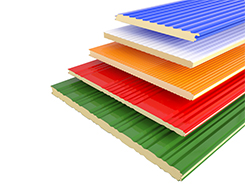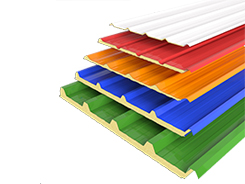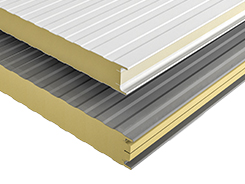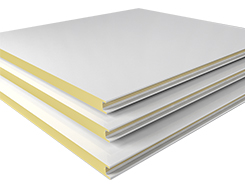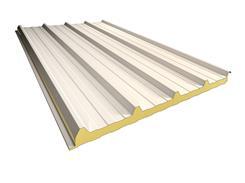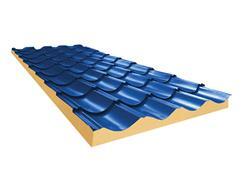Sandwich Panels
Sandwich panel is a stable and light three-layered structure
During the production process, a deeply stable connection is applied between the layers in a way that makes sandwich panels with an integrated structure.
Types of Sandwich Panels In Iran
Sandwich panels are divided into 3 types regarding insulation and 2 types regarding application. these different types of sandwich panels are available in a wide range of variety. Usage and calculation are two factors that determine the appropriate type of sandwich panels for any structure. Nowadays, regarding modern machines and C.N.C, there is a great variety of roof and wall sandwich panels.
- Double sided wall sandwich panel
- Hidden screw wall sandwich panel
- Single sheet wall sandwich panel
- Special sandwich panel
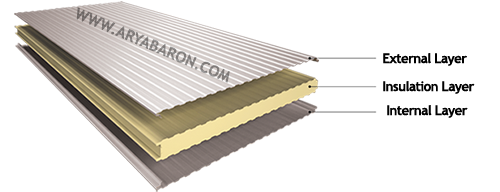
What are sandwich panels?
Roof sandwich panels and wall sandwich panels are fabricated lightweight compounds which consist of two external layers and one core layer that ensure insulation.
Advantages of sandwich panels
- Earthquake resistant
- Beauty and color variety
- Save energy costs
- low maintenance
- high sustainability
- easy transfer and application
- Etc.

Usage Of Panels
Where to use these panels? Currently this prefabricated product is used to cover the roofs and walls of residential, official, commercial and educational buildings, industrial halls, Coldrooms, clean rooms, hangars, agricultural sheds, gyms, silos, ranches, hen houses, and so on.
Factors affecting the quality of polyurethane sandwich panels
Quality of the top layer and the bottom layer of the sandwich panel
Based on the usage, the top and the bottom layers are either made of stainless steel, aluminum, copper, PVC, fiberglass, galvanized or pre-painted Aluzinc. Since the Galvanized and Aluzinc sheets are more commonly used, we provide more details about these sheets at this section. As you can see in the following image, the sheet is made of multiple layers and the sheet thickness is in fact the thickness of all these layers combined. the appropriate thickness of the top and bottom layer of a sandwich panel with intended stability is between 0.3 to 0.7 mm, although panels with 0.5 mm thickness is more commonly used and utilizable.
When it comes to the thickness of the sheet it is essential to retain the standard and suitable thickness of layers, especially the base sheet which is the main factor for sustaining stability; so using a nonstandard base sheet which is thinner than standard range, then compensate the thinness with multiple layers of cheap paint to reduce costs is an unprofessional conduct that will never be followed by AryaBaron.
It should also be noted that the epoxy layer behind the sheets is responsible for creating better adhesion between the sheet and polyurethane foam, and if this epoxy layer is removed to reduce costs, the adhesion between the foam and the sheets will not be adequate.
The quality of the paint used to color the sheets, the condition of the production lines and methods of painting, washing and degreasing have an impressive effect on the quality of the pre-painted sheet.
In order to ensure the desired quality and standard of the input sheet is fulfilled in the production lines, Arya Baron prepares the sheets directly from reliable companies such as Mobarakeh Steel Factory, besides all the quality control standard tests are conducted on every product before entering the company’s production line, such as: salt spray test, measurement of paint thickness and paint resistance to bending and crashes.
The quality of the polyurethane foam used in sandwich panels
Polyurethane foam is the product of a combination of isocyanate, polyol and several other additives mixed with catalysts.
The quality of these raw materials has a direct and deep effect on the quality of polyurethane foam of the sandwich panels.
Polyurethanes were first discovered by Otto Bayer in Germany in 1937, and since then these materials, with their special properties, have greatly advanced in various industries around the world. The first polyurethanes were produced from the diisocyanate reaction. Polyurethane (also known as Alitanes) are compounds that have a urethane bond in their structure.
Polyisocyanates (PIR) are chemicals of the same family as polyurethanes, which are mostly used as insulation, and the percentage of MDI in this foam is higher than PUR foam. In equal conditions, the insulation of PIR is more than PUR. PIR’s fire resistance is also higher than PUR’s (B1). Based on new findings, the less is the coefficient heat transfer, the more efficient is the insulation of Polyurethane. This sufficient effect is achieved when the density is ranged between 35 kg/m³ to 50 kg/m³. various tests have been conducted and the results show that the best and most optimal density of sandwich panels in the above range is the density of 41 kg/m³. In many cases, only the density or volumetric mass with the same density of foam is wrongly considered a necessary and sufficient condition for a desirable and high quality foam.
Needless to say, the polyurethane foam is an organic material and its main function is insulation. Now, if this organic matter is mixed with heavy minerals such as mill or rock powder, and even with polyurethane milling materials, the desired density can be easily achieved; While, the desired standard of insulation won’t be achieved and as a result thermal insulation will no longer be at the standard and acceptable level.
The degree of insulation of the foam, which directly depends on its coefficient of heat transfer, is an important quality parameter that requires special attention. With relevant devices, we measure the coefficient of heat transfer and to ensure the purity of foam layers from the presence of unauthorized organic and mineral additives, we use a laboratory microscope. Another important feature of polyurethane foam is its fire resistance, the neglecting of which can lead to severe damage.
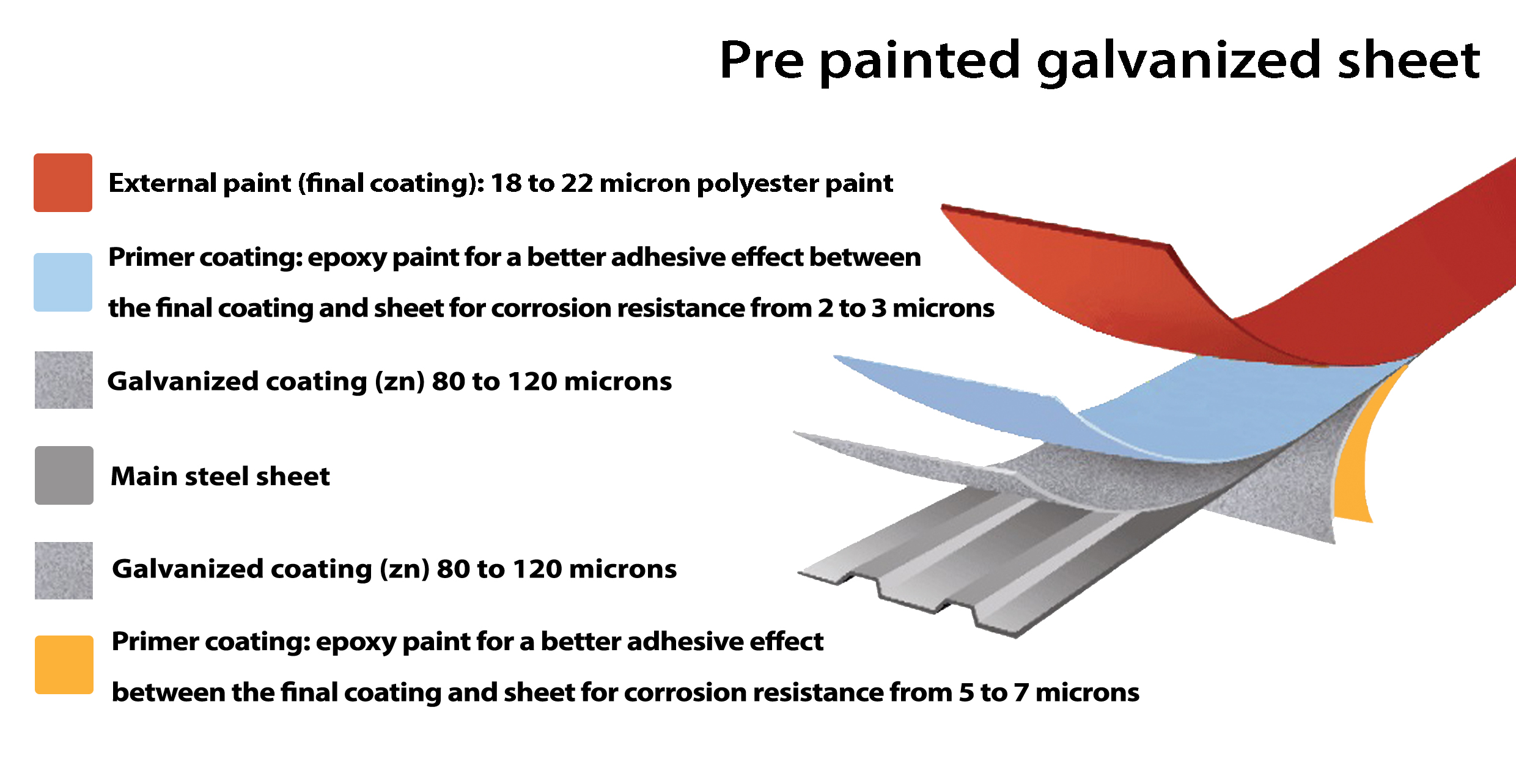
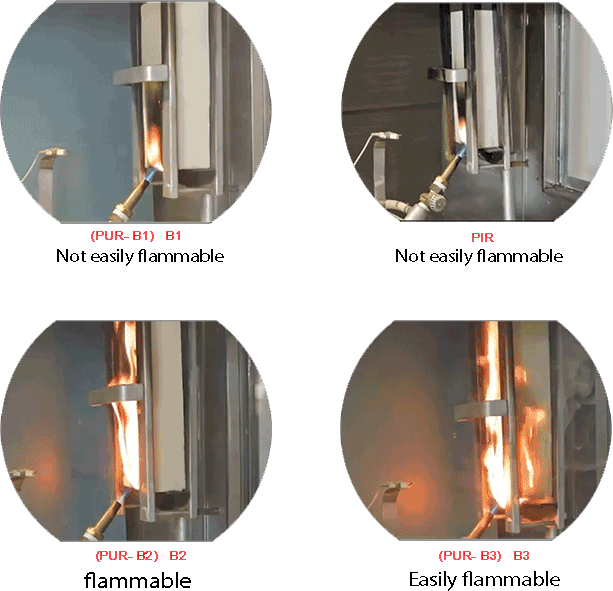
The quality of machines in production line
Polyurethane foam production machines require a high level of technical knowledge, and even some European countries that have been working in the field of producing such machines for many years have not yet been able to achieve the details and tricks of the trade.
Arya Baron believes that the reason behind the expensive manufacturing machines of top quality European brands are their superior quality, and based on this, years ago the company started its activity with advanced polyurethane foam machines from O.M.S. Italy.
Factors affecting the quality of rock wool sandwich panels
The quality of the top layer and the bottom layer and its proper selection
It is worth noting that when it comes to the thickness of the sheet, it is necessary that the thickness of each layer would be standard and suitable, never use a thinner than standard range base sheet which is responsible for the main stability in order to reduce the costs and try to compensate the lack of thickness by using cheap painting layers.
It should also be noted that the epoxy layer behind the sheets is responsible for creating better adhesion between the sheet and polyurethane foam, and if this epoxy layer is removed to reduce costs, the adhesion of the foam to the sheet will not be adequate.
The quality of the paint used to color the sheet, the condition of the production lines and methods of painting, washing and degreasing have an impressive effect on the quality of the pre-painted sheet.
In order to make sure the desired quality and standard of the input sheet is fulfilled in the production lines, ArYa Baron prepare the sheets directly from reliable companies such as Mobarakeh Steel Factory besides, all the quality control standard tests are done on every product before it enters to the company such as: salt spray test, paint thickness measurement and paint resistance to bending and crashes.

The quality of rock wool
Rock wool is one of the best thermal and acoustic insulators that is currently one of the most used materials for insulation all over the world. Rock wool’s thermal stability reaches up to 750 ° C.
Apart from being light, rock wool is non-toxic, recyclable and environment friendly, it also has good physical and chemical dimensional stability. It is also protected against the growth of pests, bacteria and fungi. Thus, rock wool is one of the best thermal and acoustic insulators for the oil, gas, petrochemical, construction and other industries.
In some rock wools, slag from iron furnaces and some molds are used instead of basalt, and to compensate for the shortcomings caused by this misconduct, illegal flammable resins are used more than the standard amount. These rock wools have a much lower fire resistance.

Use of skilled workers in the production process
Skill is a mixture of expertise and experience. And the necessary condition for the optimal use of modern machinery and quality raw materials is the presence of skilled workers in the production cycle. Arya Baron in order to lead the company’s operators and production staff to produce quality and durable products with desirable raw materials and using modern and sophisticated machines at appropriate intervals has considered foreign and domestic training courses and seminars in the company as well as inviting foreign and internal professors and put it in the program of the company.
Production methods and machines
Because rock wool is layered with intertwined fibers, it is inherently soft and easily breakable in layers. For this reason, after the brick rectangles are arranged between the two sheets in a cube, not only is there a gap between the joints, but also the parts of the crotch and the tongue or the overlaps do not have the necessary strength even in the installation stage.
Arya Baron has long sought to fix these two major drawbacks of rock wool sandwich panels so that customers can enjoy the many benefits of these panels without a single worry. In this regard, and to address these two shortcomings, Arya Baron has introduced rock wool sandwich panels to the market by injecting PIR on both sides. In this type of special panels, polyurethane injected at the two side edges in the first stage compresses the rock wool blocks together and eliminates the distance between them, and in the second stage in the crotch and tongue or overlap of the insulation and high strength between Creates top sheet and outsole.
Definitions and units
Density or volumetric or complex mass
To measure how compact an object is, that is, how much space there is in between the components of an object, we need a unit called density. High-density objects have less free space in their crystal lattice. The unit of measurement in SI system for density is kilogram per cubic meter (kg/m3) and the density of an object is calculated by dividing its mass by its volume. The density of an object placed on a scale is obtained from the number of grams (mass of the object) divided by the amount of space occupied by the object (its volume). The density of objects is usually compared to the density of water to see if they float on surface of water or they sink. The density of water is about 1.00 g / mL or 1000kg / m³.
If the physical density is greater than water, it will sink in the water, and if it is less than water, it will float. Usually, the optimum density of polyurethane sandwich panels is between 40 and 44 kg/m3, which is written as 42 ± 2 kg / m³. The conventional density of high-consumption insulation in the sandwich panel industry are as follows:

Insulation
Heat always flows from higher temperature systems to lower temperature systems, and this phenomenon is inevitable. But the rate of this flow can be reduced in a large extent, and this is the main purpose of thermal insulation.
Thermal insulation is a process that reduces the rate of heat transfer between different physical systems and, simply put, prevents the loss of thermal energy of a system as much as possible.
Thermal insulation minimizes the loss of thermal energy in buildings and structures, as well as industrial buildings and equipment, and consequently leads to energy cost savings.
Other benefits of insulation include better temperature control, prevention of frost and equipment breakdown, and all of these benefits depend on the type of insulation and fire resistance.
It is common that in the insulation of buildings and structures, the thermal resistance coefficient (R-value) of insulation is important and the optimality of insulation is measured by this parameter.
Thermal resistance
Thermal resistance is a physical property that indicates the resistance of each material to heat transfer due to temperature differences. Thermal resistance is denoted by R, which has a unit of k/w.
The resistance of insulation materials to conductive heat flow is determined by the thermal resistance R-value. The higher the R-value is, the better the performance of the insulation would be. The R-value depends on the following factors:
- Type of insulation
- Thickness
- Density
The R-value of polyurethane foams is higher than other types of insulation materials, which makes it a good insulation material.
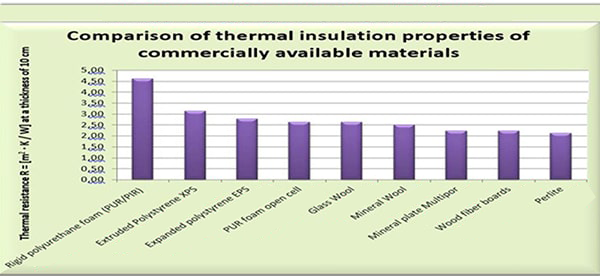
Thermal Insulation
Each industrial or natural material has its own thermal conductivity. Thermal conductivity is the amount of thermal energy that matter can pass per unit of area, unit of thickness, unit of time, and at a given temperature. The lower the thermal conductivity, the lower the heat transfer capacity and the more suitable the insulation. Since heat is always flowing from a warmer environment to a colder one, it is necessary to choose the best insulation suitable for the environment with the appropriate density to save energy costs.
The following figure shows how thick the different materials are in terms of insulation. For example, instead of a 172 cm thick brick wall, a 5 cm thick polyurethane wall will suffice

Coldroom sandwich panel
One of the challenges of coldrooms, whether during installation or operation, is the proper connection and precise sealing of the sandwich panels to each other. Although the skill of installation and accuracy is also effective in this issue, the crotches and tabs should be produced in a standard and organized manner, that is proper design of the geometric shape, accuracy in dimensions, absence distortion and contact surface material. The best way to improve the air quality of coldrooms is to reduce the number of joints between the sandwich panels. For the first time in Iran, Arya Baron succeeded in producing wide coldroom sandwich panels with a width of 120 cm. When the walls and ceiling of a cold store are covered with 120 cm wide sandwich panels, the number of joints is reduced by 20% compared to the traditional 1-meter-wide sandwich panels, or in other words, the challenge of sealing the coldroom without any changes using just a wide panel is reduced by 20%.
Shadow line sandwich panels
Shadow line sandwich panels are among the exclusive products of Arya Baron Toos brand. Shadow line sheet is one of the most widely used sheets for making sandwich panels. The use of this sheet has several advantages, including the reasonable price, high strength and durability, as well as its quick and easy installation.
AryaBaron Company; Manufacturer of Sandwich Panels, Refrigerator Doors, Conex Boxes, Prefabricated Buildings, Industrial sheds and pre-insulated ductwork is one of the largest exporters in Iran. Offering the highest quality products and using the latest European advanced product lines is AryaBaron’s top priority. AryaBaron is the symbol of trust and quality of Iranian products.


